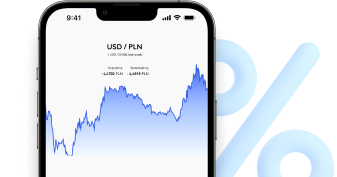Exchange rate EUR - Euro
The euro is the single currency in the euro area countries in the European Union and in 11 countries and territories outside the EU (the Vatican, Monaco, San Marino, Andorra, Kosovo, Montenegro) and in the French possessions in the Atlantic and Indian Oceans.
Select currencies and check rates
Live rates.
Update: 30s
| Currency | Buy | Sell | Name | Currency code |
|---|---|---|---|---|
| EUR PLN | 4.1504 | 4.2076 | Euro | 1 EUR |
Euro exchange rate - chart
Last currency comments
Over 900 000 reviews
Customers rate us 4.9/5.0.*
Start saving today
Forget about unfavourable rates and hidden fees. See how much you can save. Create a free account and start converting currency online.
Open account for freeEuro
Euro is a common currency used in many countries of the European Union, as well as in countries outside the EU that decided to adopt it as an official means of payment. This is one of the most important currencies in the world. It forms the main currency pair - the EUR/USD.
Euro - where is it used?
The euro has been the common currency of most countries that belong to the European Union, forming the so-called eurozone ore euro area. It is the official currency of Austria, Belgium, Cyprus, Estonia, Finland, France, Germany, Greece, Spain, the Netherlands, Ireland, Latvia, Lithuania, Luxembourg, Malta, Portugal, Slovakia, Slovenia and Italy. The common currency is also used in countries that do not belong to the European Union. Residents of Andorra, Monaco, San Marino and Vatican City also accept it under official agreements. One may also travel to Montenegro and Kosovo with euro in hand, although the currency was adopted there without official EU agreements. The European currency is also valid in the territories dependent on France. Therefore, we recommend checking the euro exchange rate before visiting such countries as French Guiana, Guadeloupe, Martinique, Mayotte, Reunion, Saint-Barthélemy, Saint-Martin and Saint-Pierre as well as Miquelon. The euro is such a popular currency which means that one can pay with it even in countries that have not officially adopted it, especially if they rely heavily on tourism. There should also be no problem with exchanging euro for a local currency in an exchange office in Europe, e.g. EUR to GBP.
The history of euro
Plans to introduce a common currency for many European countries were made as early as the 1960s. These plans were realised based on the Maastricht Treaty of December 1991. Four years later, a name was chosen in Madrid, and on January 1, 1999, the euro (EUR) made its debut in non-cash transactions. Banknotes, coins and cents became legal means of payment in 12 EU countries on January 1, 2002. Since then, the eurozone has been enlarged several times to include other EU countries that have voluntarily agreed to join. The EU wants to introduce the single currency in all member states by 2025.
The euro - key information
Euro is the youngest of the Old Continent's currencies. It is divided into 100 cents. Banknotes with denominations: 5, 10, 20, 50, 100, 200 and 500 EUR differ from most used in other countries because they do not show national heroes. They depict elements of historical buildings, characterised by the style of a chosen era. An exception is the highest denomination with a fragment of a modern office building. Each object has been presented in such a way that it does not bring to mind existing buildings, but only represents its architectural style. The 500 euro banknotes are no longer printed for reasons of combating illicit financial flows and terrorist financing. However, they can still be used until they are completely removed from circulation. The coins have one common side, which represents Europe and the denomination. The other side differs in appearance from one EU country to another while remaining valid throughout the euro area. Therefore, the obverse side of euro coins is often referred to as the national side. Denominations available are 1, 2, 5, 10, 20 and 50 cents and 1 and 2 euro.
What determines the euro exchange rate?
When travelling or doing business in Europe, the euro is the first choice of most people. For this reason, the euro exchange rate (e.g. EUR/PLN) and its forecasts are extremely important. As with other main currencies, the exchange rate is dependent on a number of changing factors. These include, among others, the current politics of the member states or the economic situation in the European Union. The economic slowdown in the eurozone negatively translates into the currency value, which is used in the Old Continent's largest economies. At the same time, economic recovery in the region of the common currency may cause its appreciation against, for example, the dollar. Also, the level of interest rates has a significant influence, which is why the European Central Bank is extremely cautious about changing them. This is one of the reasons why the euro exchange rate usually remains relatively stable against other main currencies of the world. When going abroad or converting currencies, it's a good idea to check the current EUR exchange rate in order to know what the EUR/GBP rate is, for instance. Charts on our website will also help you keep track of the euro average exchange rate, and a currency converter will help you calculate the amount.






























